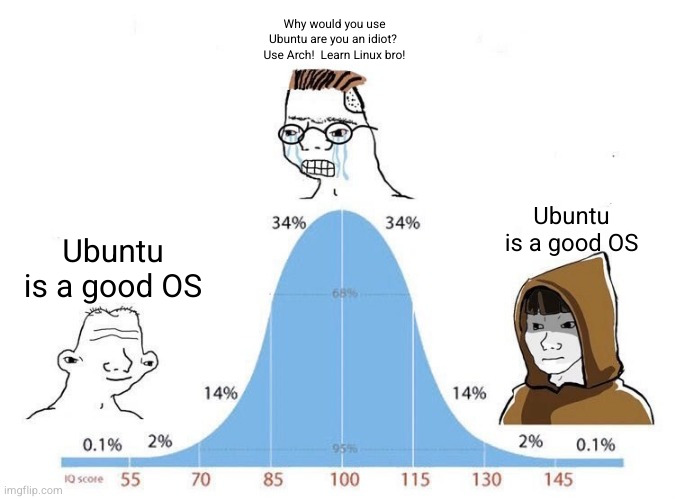Alt text: A line plot with 2 axis (confidence vs competence) referencing the Dunning-Kruger effect with various distro logos placed at different points on the line. Starts with mint/ubuntu near (0,0) and progressing through multiple distros to end up with opensuse/fedora at what it calls “the plateau of sustainability”
I assume Hannah Montana Linux is off the chart to the right
Hannah Montana Linux, or HM/Linux as I’ve taken to calling it, is the sign of true civilization.
I am so sick of seeing this ridiculous diagram being labeled the “Dunning-Kruger effect”. Go read the actual 1999 paper they wrote. The key takeaway is that the lowest quartile of people tend to overestimate their own performance, and the top quartile underestimate theirs. It doesn’t posit anything like this graph, and this is just an ironic example of ignorance.
And second, I am so sick of seeing these ridiculous distro comparisons. Stop with this elitism, even if done humorously. People of all experience levels can be found using different distros, and they all have unique advantages, disadvantages, and communities built around them. Don’t shame the great effort that people put into maintaining and developing distros, repositories, and packages. A noob can use Arch, and a master can use Ubuntu. Use what appeals to you, and be happy in knowing you can experiment or stick to anything. This is the beauty of FOSS and the Linux ecosystem; it’s a great place for both tinkerers as well as those who want familiarity. There is no one true way.
I went from Ubuntu to Mint to Debian and, now, Guix; so…I dunno.
Meh, I’m relatively experienced and just use Ubuntu
That’s because you use your computer and it’s not part of your personality. I’m reasonably well versed in Linux and I’ve used Pop for years.
Arch had been rock solid for me since 2012…
I use opensuse tumbleweed
I chose Tumbleweed for my first desktop Linux install a couple of months ago. Only had some minor issues so far (like missing codecs).
Although I recently tried to build a Kwin plugin, and even though I figured out the build dependencies, it didn’t show up as expected, not sure what’s going on there.
There are several of us!!
Twelve years in, cloud engineer, have Mint on all my home machines cos i dont have to think about it. I like your chart but its dumb.
30 years of using Linux and I think this chart is whack. RPM based distros run by enterpises are the worst. I was happier with Slackware than Fedora. 🤣 I only use those when work forces me too and after the CentOS and SLES fiascos - F that noise. I’ll only recommend debian for work servers unless there are STIG/FedRAMP security requirements and then it’s begrudgingly over to Ubuntu.
When work isn’t in the way: EndeavourOS on my desktop, Debian on my servers, and debian/alpine for my containers or better yet; golang and scratch.
Debian. Anything to the right is lies.
I appreciate Debian being the community distro, but other than that, how’s it much better?
After a while, you start to realize Ubuntu (or insert any Debian-based distro) is great because of it’s wide usage, and it mostly just works.
But then, you realize Snaps slow things down, or some other piece is annoying. Most of the time, these are things added on top of Debian.
So then you realize you can just run Debian, and pick and choose the parts you want from other distros.
I want to see a graph where X ranges from “ambitious” to “I’m so tired”, and Mint is at the end. That’s where I’m at.
Starting fights today are we?
Gotta dig in early before the pesky Americans wake up
Brother you posted this at the Americans’ lunch time (or second breakfast for the pacific coasters) ?? They were already arguing and here you come with petrol and a lit match
i’m on NixOS
…and I’ve been on NixOS for mount stupid, valley of despair and, perhaps, the plateau of sustainability
Truely don’t understand how this one became popular. But I’m sure it will fade like Crunchbang or a dozen others before it.
Mint, and I’ll stay with mint. Perhaps I’m not a good Linux user material, but I just want something that works and doesn’t get into the way. You know: a reliable, unobtrusive operating system.
Mint is just perfectly fine, don’t listen to the naysayers.
As the old observation goes, novices use something like Mint because it’s there, and it works; intermediate users use something like Arch because they want the control to tweak things in the greatest depths; experts use something like Mint because it’s there, and it works.
And there’s no shame in that! Use whatever works for you and don’t let anyone tell you otherwise.
There is SO MUCH shame in that, the pitiful noob wont even learn to RTFM, and then I’ll have no way to feel superior to them as I dip my beard into my off brand morning cereal #frostedfakes
Which is exactly what OpenSUSE/Fedora have to offer. It just works and doesn’t get in the way. The only real difference between them and Mint in terms of user experience is that they require some more proficiency with the terminal and experience with Linux overall and do not assume user to be a complete newbie.
So, you’re on the right track with Mint. It holds to nearly the same philosophy, and offers you the tools you may find useful as a less proficient user. Keep it up!
why is manjaro there twice? it’s a horrible experience no one in their right mind would return to
“Maybe I was the problem?”
they managed to make arch less stable, never update their ssl cert, and every installation slowly falls apart until it’s unusable… sure, I’m the problem
You are, by installing it in the first place.
My system I installed 10 years ago is unusuable now?
“I donated money to them so I am going to use it.”
Although not much, just 20 EUR. Not sure how much the bundled Windows license costs, but surely Microsoft has other ways to earn from spyware.
Look, don’t judge me, but manjaro has been the only distro to just work. I haven’t been fucked by nvidia drivers that I know of, I haven’t had any glaring issues… I’m not saying I disagree with the criticisms, but as a ‘just use the fucking computer’ distro, it’s great.
As someone who ran Manjaro as my first Linux for 1,5 years, it’s a breeze to set up and everything just works…until it doesn’t.
What screws it is that eventually, over time, something goes wrong. Something breaks here and there, new bugs appear, and without Arch proficiency that is not really expected of a Manjaro user, it’s next to impossible to track it down. So, eventually one has to reinstall.
I’ve been a strong Manjaro proponent back in the day, but now I see its flaws, unfortunately. I wish it could be a great option, though.
Lol, that does make me wonder. I think I changed the boot process from silent to visible at one point, because it wouldn’t boot if the silent option was enabled.
That’s…very odd :D
Especially if it was GRUB. This thing normally just works on any distro, even the less stable ones.
Yeah, it was grub. I changed it to see if I could find where it was hanging in the boot process, but as soon as I made the change it would simply boot without issue.
Manjaro is a tempting option when you want Arch without being competent enough to confidently operate Arch.
Been there before. Had it for over a year for the first time, but quickly noped out on the second try.
I love my Manjaro. I always come back to it… but I may not be in my right mind.
To be fair, it’s OK. Just you might want to check out EndeavourOS when you need to format your PC again.
I have both and I like them almost equally.
I think I’ve seen this story before. :P

I love that !
Fedora is also there twice.
This is perfectly normal.
It also works with a Gaussian: (Noob) haha Fedora go brrr -> (angry advanced) nooo you must use Arch/Nix/Gentoo/Slackware -> (Linus Torvalds) haha Fedora go brrr

Canonical: snap snap snap snap snap snap snap snap snap
What’s the issue with snaps? I’m still on Ubuntu ans abkut to switch to Debian, but for me its pretty chill atm because I don’t have to worry about updates or security. I know about the terminal aliases, which could be disclosed better, but it’s not that big of a deal to me. I thought it’s pretty cool to have a “store” that’s curated so I don’t have to worry about security, since I use Linux casually.
I’ll just repost this repost of my personal experience then:
Here’s my answer to this same question from an old thread on Reddit:
My Ubuntu system always reserved a whopping 20% of my 32GB ram for no reason and I never bothered to know why. Later I uninstalled snapd because of boot time issues and guess what happened? Only 1.5 GB used after a fresh boot.
I had like 4 different JetBrains IDEs installed via snap with each totalling around 2GB of disk space. While removing snapd I discovered it kept back 2-3 previous versions of every package on your disk.
Uninstalling this bloat was the best thing I did to my ubuntu system. It was suddenly light as a feather and way more responsive like I just did a fresh system install.
Some time later I was installing something from apt and Ubuntu tried to install it from snap, thus sneakily installing snapd in the process. Looking for a solution, I felt like I was looking up how to disable Windows updates or some other shit.
I had a moment of clarity and wondered why the fuck did I have to put up with this kinda bullshit on Linux. I wiped that drive clean and switched to Fedora.
Edit: and there’s also flatpak which-despite being awful in some ways-is better than snap in every conceivable way.
Thank you for clarifying that!
















